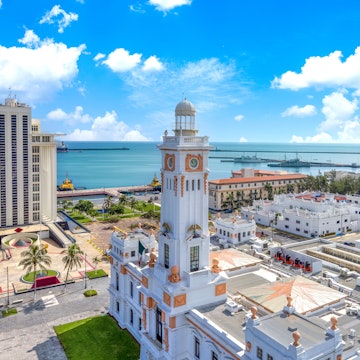

A surfer in Lima. Even in the city’s wettest, foggiest months, the Pacific Ocean beckons. Sergio TB/Shutterstock
Whether you’re visiting Lima as a destination in its own right or just passing through en route to Cuzco and the Andes, there’s no bad time of year to visit.
Every month, you’ll almost always find something on the cultural calendar, and the Peruvian capital serves up world-renowned restaurants, top museums and direct access to the Pacific Ocean year-round.
While you’ll never have a bad time here, Lima is at its best and most beautiful in the summer (December to March), when the beaches fill up by day and the bars spill out into the streets by night. Still, Lima tends to see a spike in visitors during the winter (June to August) as this is the driest time to hike to Machu Picchu.
But even when fog cloaks Lima and the city skies turn gray, numerous festivals between July and October help to enliven the mood. Read on for all the best times to visit Lima.

The high season (June–August) is the best time for festivals and slow travel
Although Lima’s winter months see hordes of tourists, few visitors plan on spending a significant time in the capital. Instead, most treat their time here as a stopover, before heading off to explore Machu Picchu and other wonders in the Andes, as the dry winter weather is ideal for hiking in the mountains. Nevertheless, with so many visitors in town, even for such short stays, prices are high and you’ll need to make reservations at hotels and high-end restaurants in advance.
Toward the end of June, days become shorter and skies become gloomier, making this a good time to visit Lima’s museums and free galleries and eat at some of the city’s superb restaurants. The city hosts Lima Pride Week (late June to early July) around this time, too. Average temperatures hover around 20ºC (68ºF), making bike rides and strolls along the malecón (waterfront) an enjoyable way to keep busy.
In mid-winter, the city starts making preparations for the annual celebration of Peru’s independence on July 28 and 29. You’re sure to notice a tangible sense of glee among locals – so take advantage of this spirit of patriotism and chat with vendors at markets and patrons in cafes to learn more about Peru’s culture and heritage. To close out the festivities, Lima stages a grand parade near Miraflores’ Parque Kennedy.

The shoulder seasons (September–November and April–May) are best for sunshine and budget travel
After the heat of January, February and March has worn off, Lima sees a lull in tourism before peak season ignites. Another quiet period marks the transition from the cool winter to the warm, humid summer – and this is a great timeframe for a budget jaunt to the city. Reservations at top-ranked restaurants are easier to come by, prices in hotels take a slight dip and the odd ray of sunshine might just burst through. Note that Semana Santa (the week leading up to Easter) in late March or April is a big holiday domestically and hotel prices skyrocket.
In April, falling temperatures and cooling waters in the Pacific make for great paddle boarding or kayaking, without needing to rub elbows (or oars) with lots of other people. During the second shoulder season (September to November), the bulk of the hiking tourists will have passed through, emptying central areas of Lima. This is a good time to consider a day trip to Reserva Nacional de Paracas to see sea lions and get a welcome dose of vitamin D.
October is a big time for religious celebrations. Catholics wear purple in tribute to a famous image of Cristo Moreno that miraculously survived multiple earthquakes. Try and find some traditional turrón de Doña Pepa (a sprinkle-topped, anise-flavored cake) to sample: it’s only served during this time of year.

The low season (January–March) is the best time for sunny weather in Lima
When tourist crowds dwindle, Lima's 11 million or so residents come out in force during the summer months. From January to March, the sun shines brightly and clear skies abound – fooling visitors into thinking that Lima is like this all year round. Do as locals do and get active by surfing, paddle boarding or kayaking along Lima’s coastline. Consider exploring the beaches of the southern Lima region, or taking a hiking day trip during this warm time of year.
February is the hottest month of the year in Lima, and also the month of carnavales in Peru. The days of city-wide water fights in the capital are long gone (and now officially prohibited), though many bars and live-music venues in Lima schedule special events, promotions and concerts to mark the traditional festivities.
Locals pack out cevicherias (ceviche restaurants) to enjoy fresh seafood plates between January and March as the daytime temperature hovers around 24ºC (75°F), matched with a high humidity level that becomes almost unbearable in February.
Sunny days lead to incredible sunsets, followed by warm nights that are great for going out to discover new watering holes and live-music venues with an icy brew or pisco cocktail in hand. This is also a great time of year to look for cheap vacation rentals in Lima, as many upper-class limeños migrate to their beach houses for the season.
















